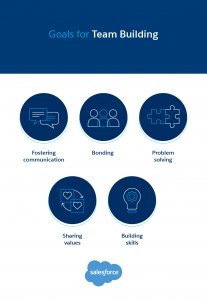primary goals of team-building activities
The primary goals of team-building activities are to strengthen relationships, improve communication, and promote collaboration. This is essential in today’s work environment where teams are spread out across the country and world, some working remotely for much of the time. Regularly scheduling team bonding and collaborative sessions creates a sense of camaraderie that leads to better employee morale, productivity, and more.
What’s more, Teambuilding can help to bring different departments together as a unified group, encouraging cross-functional working that will be beneficial for the company as a whole. Creating strong connections between staff members from different departments can also be an incentive for employees to stay in their roles instead of looking elsewhere for career opportunities.
It’s no secret that a great culture in the workplace is one of the most important things that a business can do to retain its best talent. Providing fun and engaging team-building activities for employees to participate in can be a great way to boost morale, particularly after big changes that have been ushered in such as new management or a merger.

What are the primary goals of team-building activities?
Many team-building activities, especially those focused on building a stronger connection between employees, will involve some sort of playful competition. Quirky challenges such as blindfolding a colleague and having them verbally describe how to draw a picture or getting over a rope without stepping in “lava” might seem silly, but they all serve a purpose. In addition to the fun, these activities encourage creativity and out-of-the-box thinking which can be a valuable tool to have in any workplace.
A key takeaway of a lot of team-building activities is teaching staff that they can solve problems and achieve success as a team. This is often achieved by putting groups in challenging situations where they have to work together to accomplish tasks, such as completing a scavenger hunt or escaping from a locked room. Developing problem-solving skills can be invaluable for any workplace, but especially for remote workers who don’t get the same chance to collaborate in person with their colleagues.
Another common goal of team-building is to discover and develop leadership skills amongst staff members. This can be done by allowing staff to lead particular scenarios or teams during an activity, or by looking for people who naturally demonstrate leadership qualities. It’s often the case that a natural leader will emerge during a team-building activity, and by making this an important desired outcome it can be encouraged to occur more frequently in the workplace.
Finally, improving and maintaining effective communication is the most important objective of any team-building activity. Without it, issues will be misinterpreted and errors will happen. It’s essential that all employees can communicate effectively and have a safe space to raise issues, share opinions, and disagree in a positive manner. During team-building, this can be encouraged through communication games that encourage healthy competition and open discussions, or simply by giving staff the opportunity to relax and have some fun together.